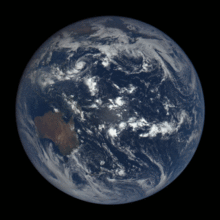


Inastronomy, the rotation periodorspin period[1] of a celestial object (e.g., star, planet, moon, asteroid) has two definitions. The first one corresponds to the sidereal rotation period (orsidereal day), i.e., the time that the object takes to complete a full rotation around its axis relative to the background stars (inertial space). The other type of commonly used "rotation period" is the object's synodic rotation period (orsolar day), which may differ, by a fraction of a rotation or more than one rotation, to accommodate the portion of the object's orbital period around a star or another body during one day.
For solid objects, such as rocky planets and asteroids, the rotation period is a single value. For gaseous or fluid bodies, such as stars and giant planets, the period of rotation varies from the object's equator to its pole due to a phenomenon called differential rotation. Typically, the stated rotation period for a giant planet (such as Jupiter, Saturn, Uranus, Neptune) is its internal rotation period, as determined from the rotation of the planet's magnetic field. For objects that are not spherically symmetrical, the rotation period is, in general, not fixed, even in the absence of gravitationalortidal forces. This is because, although the rotation axis is fixed in space (by the conservation of angular momentum), it is not necessarily fixed in the body of the object itself.[citation needed] As a result of this, the moment of inertia of the object around the rotation axis can vary, and hence the rate of rotation can vary (because the product of the moment of inertia and the rate of rotation is equal to the angular momentum, which is fixed). For example, Hyperion, a moon of Saturn, exhibits this behaviour, and its rotation period is described as chaotic.
| Celestial objects | Rotation period with respect to distant stars, the sidereal rotation period (compared to Earth's mean Solar days) | Synodic rotation period (mean Solar day) | Apparent rotational period viewed from Earth | |
|---|---|---|---|---|
| Sun* | 25.379995 days (Carrington rotation) 35 days (high latitude) |
25d9h7m 11.6s 35d |
~28 days (equatorial)[2] | |
| Mercury | 58.6462 days[3] | 58d15h30m30s | 176 days[4] | |
| Venus | −243.0226 days[5][6] | −243d 0h33m | −116.75 days[7] | |
| Earth | 0.99726968 days[3][8] | 0d23h56m 4.0910s | 1.00 days (24h00m00s) | |
| Moon | 27.321661 days[9] |
27d7h43m 11.5s | 29.530588 days[9] (equal to synodic orbital period, due to spin-orbit locking, a synodic lunar month) | none (due to spin-orbit locking) |
| Mars | 1.02595675 days[3] | 1d 0h37m 22.663s | 1.02749125[10] days | |
| Ceres | 0.37809 days[11] | 0d9h4m 27.0s | 0.37818 days | |
| Jupiter | 0.41354 days(average) 0.4135344 days (deep interior[12]) 0.41007 days (equatorial) 0.4136994 days (high latitude) |
0d9h55m30s[3] 0d9h55m 29.37s[3] 0d9h50m30s[3] 0d9h55m 43.63s[3] |
0.41358 d (9 h 55 m 33 s)[13] (average) | |
| Saturn | 0.44002+0.00130 −0.00091 days (average, deep interior[14]) 0.44401 days (deep interior[12]) 0.4264 days (equatorial) 0.44335 days (high latitude) |
10h33m38s +1m52s −1m19s [15][16] 0d10h39m 22.4s[17] 0d10h13m59s[18] 0d10h38m 25.4s[18] |
0.43930 d (10 h 32 m 36 s)[13] | |
| Uranus | −0.71833 days[3][5] | −0d17h14m24s | −0.71832 d (−17 h 14 m 23 s)[13] | |
| Neptune | 0.67125 days[3] | 0d16h6m36s | 0.67125 d (16 h 6 m 36 s)[13] | |
| Pluto | −6.38718 days[3][5] |
–6d9h17m32s | −6.38680 d (–6d9h17m 0s)[13] | |
| Haumea | 0.1631458 ±0.0000042 days[19] | 0d3h56m 43.80 ±0.36s | 0.1631461 ±0.0000042 days | |
| Makemake | 0.9511083 ±0.0000042 days[20] | 22h49m 35.76 ±0.36s | 0.9511164 ±0.0000042 days | |
| Eris | ~1.08 days[21] | 25h ~54m | ~1.08 days | |
* See Solar rotation for more detail.
| Authority control databases: National |
|
|---|